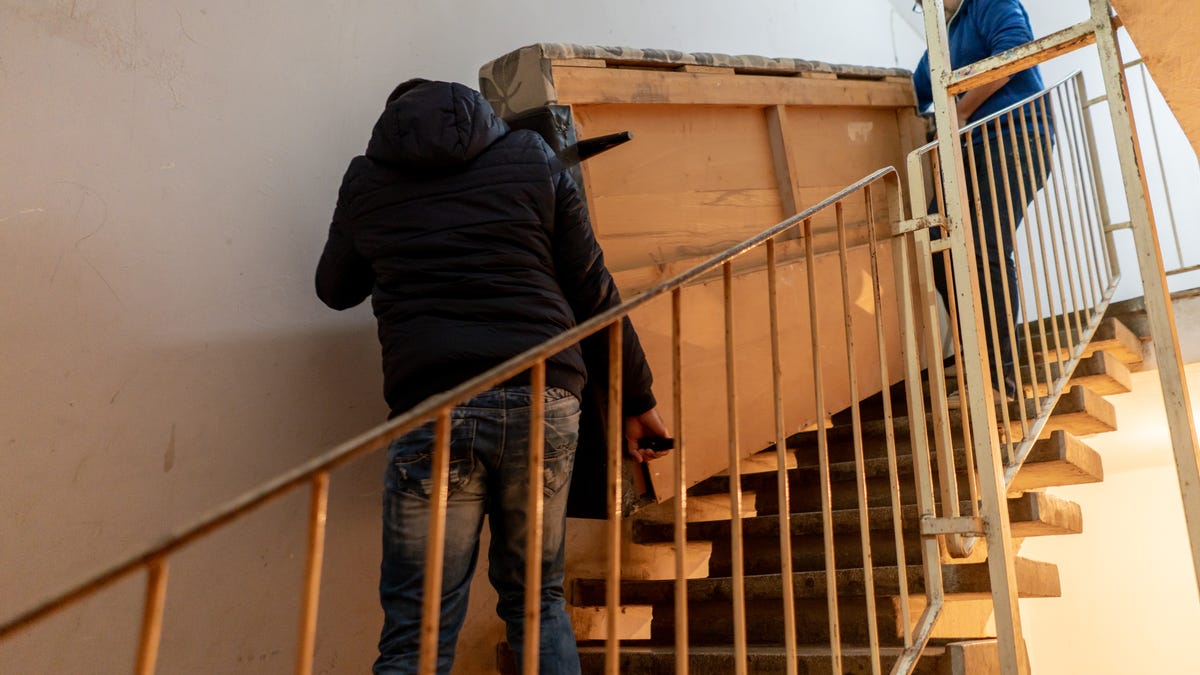 Why You Can Trust CNET
Why You Can Trust CNET Here's How to Safely Lift Heavy Boxes and Furniture While You Move
Switching addresses? A little preparation and knowledge for how to properly lift and move your stuff can help protect your health and your possessions.

Pivot! For large furniture pieces, plan ahead to navigate through tight spaces.
Moving is stressful enough. So, adding any mental or physical stress to the move by throwing your back out as you walk a 40-pound box up the stairs is less than ideal.
Lifting heavy furniture and large boxes is physically exerting, and there's always a danger of muscle pulls or other injuries. But there are ways to protect yourself.
You don't have to be able to bench 150 pounds to move your heavy furniture and moving boxes. There are plenty of tricks, like knowing the proper stance for carrying heavy objects, as well as equipment like dollies and sliders that you can use for a stress-free and injury-free move.
For more moving tips, learn how to properly deep clean your new house or apartment.
Dress appropriately for moving large items
Before you start the literal heavy lifting, make sure you are wearing clothing that supports moving big boxes and pieces of furniture. Wear comfortable clothing and close-toed shoes and tie your hair back.
Gather tools that can help
There are a few pieces of moving equipment that can make it easier to transport heavy items. They include sliders to put under furniture for easy gliding, ramps for managing stairs and hand trucks with wheels for carrying larger objects.
You can also use shoulder dollies that you strap around yourself and your moving buddy's body to utilize upper body strength while moving larger objects, as well as moving blankets and furniture wrap for protecting the structural integrity of your furniture as it gets transported.
Find helpers who are willing to lift heavy items
Sure, you could probably move all your furniture and boxes on your own with some handy tools, but a friend or a family member who is willing to help will make all the difference. Ask friends for help or hire a moving company for your heftiest belongings.
Read more: 6 Tips for Moving On a Budget
Plan your route for large furniture
Before you pick up your furniture and move it around all willy-nilly, you should have a plan and map as to how you will maneuver it out of your space. Map out your plan for big items and talk it through with your helper before you get your 8-foot couch stuck in a doorway. Similarly, make an explicit plan for moving your large furniture into your new space.
Stretch out to stay loose and healthy when moving
The last thing you are trying to do is pull a muscle or throw your back out. To prevent overexertion, stretch your body out ahead of moving.
The main parts of your body to stretch include arms, legs, back and hips. Relieve any tension or pain in your lower back prior, during or after by doing the cat-cow stretch, child's pose or the knee-to-chest stretch. For a two-in-one stretch, try spinal twists, which target your back and your hips. For arms, try the cross-body shoulder stretch and the overhead triceps and shoulder stretch. For legs, stretch out your quads and hamstrings with the standing quad stretch. And, because nothing is worse than a middle-of-the-night Charlie horse, don't forget about your calves! Practice floor and wall stretches to alleviate pain in your Achilles tendons.
Lastly, don't forget about taking breaks throughout the day for stretching and drinking water -- a dehydrated body has a higher risk of injuries and muscle strains.
Disassemble large, clunky items
Take the drawers out of your dresser, unscrew legs on chairs and couches, and break down any large furniture items into as many smaller, lighter pieces as possible.
Lift with your knees and hips and avoid lifting with your back
Avoid lifting with your waist and back muscles, which can result in overexertion and muscle strain. Before lifting, position your feet shoulder-width apart, with one foot an inch or two ahead of the other.
As you lift, begin in a squat position and slowly rise upward through your knees and hips -- not your back or your waist. Maintain proper posture and keep your back straight, making sure not to slump or shrug your shoulders as you lift.
When in doubt, hire movers
Some tasks are too difficult and heavy for our weak little limbs, and that's OK. If you aren't up to the job of moving heavy furniture on your own, you could risk damaging your pieces or hurting yourself. Know your limits and how much is too much to carry.
If you don't have anyone to help you move your belongings and you have some extra cash for movers, use it. Even if paying a mover may seem annoying, preventing serious injuries is invaluable.

